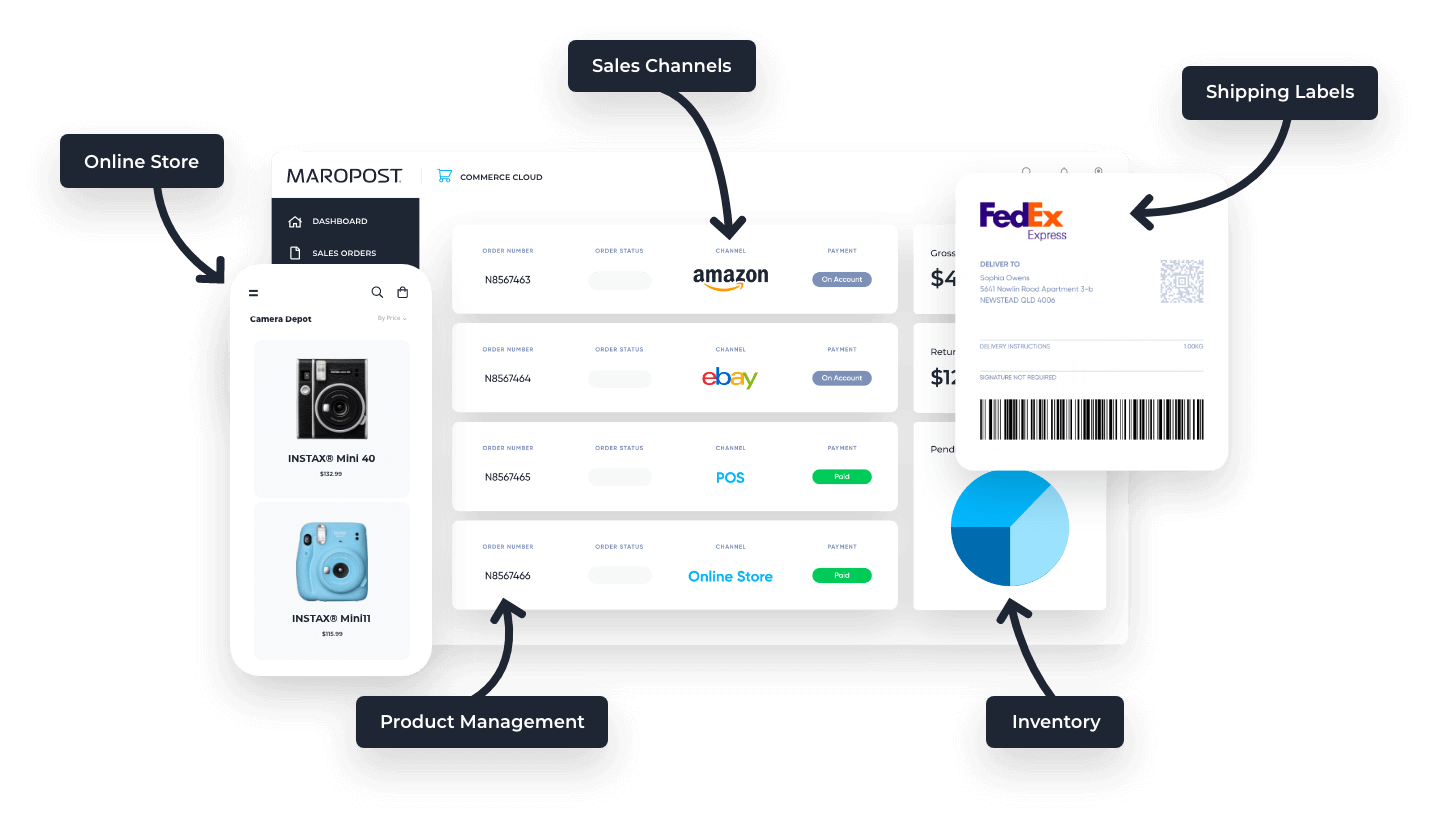So you’ve launched your first email marketing campaign. (We bet you that little task took longer than you thought!) Whether promoting a new product or attracting leads, it takes some time to pull the right headlines, copy and images together. But that’s just the first step. The next is knowing how to measure your newsletter or email marketing KPIs.
But before you can start tracking, you must know what you’re measuring.
Not all email marketing campaigns are about generating sales (although that’s likely your ultimate goal). For example, you may have other goals, such as:
- re-engagement
- generating brand awareness
- education (e.g. a blog or eBook)
- growing another email list
- collecting additional data on subscribers
Too many marketers are tracking just 3-5 KPIs for their email campaign metrics. But when it comes to KPIs for email marketing there are around 10 KPIs you need to watch to get the complete picture. To help you truly optimize your campaigns, here are Maropost’s 10 essential metrics and KPIs for email marketing.
#1: Number of marketing emails delivered
You may have 10, 100 or 1,000 names on your email list, but sadly, that doesn’t mean all these emails are being delivered. Unfortunately, a 100% deliverability rate is impossible. And there are various reasons why.
For example, if 85% of your emails make it into your subscribers’ inboxes, that means 15% might as well not exist. So, in simple terms, if you have 1,000 names on your list, 150 people never got your email.
Secondly, you need to know if there’s a sudden dip in deliverability. Sometimes, through no fault of your own, a marketer can suddenly be blacklisted by an ISP, especially if you have a shared—rather than dedicated—IP.
Suppose you realize you suddenly can’t email anyone with a Gmail address, for example. In that case, you need to act immediately to find out why — and fix the problem.
IMPORTANT CAVEAT: There’s a difference between an email being ‘delivered’ and actually making it into the inbox. How so?
Your email could very well be delivered yet go straight to a recipient’s junk folder. (Not so ideal.) That’s why more marketers are using the Inbox Placement Rate (IPR) as a KPI to measure how many emails actually make it to the inbox.
#2: Number of emails opened
Before you pop the champagne cork, making your email newsletter (or EDM) into the inbox isn’t enough. We all know how many messages we get in our inboxes. But how many do we actually open?
That’s why it is vital to note how many emails from your carefully crafted campaigns are opened. Because, after all that hard work, we want people to read these emails. And remember, if you get 85% of your emails delivered and an IPR of 79%, that still doesn’t mean subscribers are paying attention to your message. That just means they have simply landed in the recipients’ inboxes.
Not good enough. (Sigh.)
Much like email deliverability, you want to track trends in the open rate and adjust accordingly.
A good tip is to compare your open rates to what’s typical for your industry so you can have a benchmark. An industry-specific comparison is vital. For example, some industries, like finance and hospitality, typically see higher open rates (which makes sense given that people open emails from the banks and hotels they frequent).
ROOKIE TIP: Some people use preview panes for their email. These panes can register email opens that aren’t actually opened. Also, text-only emails won’t register as opens, even if they are.
#3: Click-through rate
The click-through rate (CTR) indicates how many people clicked on a link in your email to a particular destination.
However, unlike ‘opens’ and ‘deliverability’, you’ll need to dig deeper with your CTR. For each campaign, you need to know which links interested your readers the most and where those links were located.
For example, if most clicks are above the fold, you’re passing the blink test.
And here’s another consideration. Let’s say you offered the same link but worded it two different ways, and one performed better than the other. In that case, in the future, you can optimize your CTA text, accordingly, using the more successful text. Also, compare buttons to text links. And don’t forget to track the images. Track as much as you can — even the bad stuff.
What bad stuff? Unfortunately, the unsubscribe link will probably count as a click — so let’s not kid ourselves that all clicks are good.
#4: Click-to-open rate
Your click-to-open rate (aka CTO or CTOR ) is the number of email opens compared to the number of email click-throughs.
Of all the people who opened your email, how many actually clicked on a link? This metric can often, but not always, tell you how well your subject line and content work together. It’s likely that if your subject line generated a lot of opens but few clicks, there was a disconnect. Similarly, if you had few opens but many clicks, you may have missed out on an excellent opportunity. You likely had a fantastic offer but didn’t nail the subject line.
ROOKIE TIP: As attractive as they may be, stay away from clickbait headlines in your emails. Although they’re not as harmful as clickbait blog headlines, never frustrate your readers by leading them on and failing to deliver.
Other factors that influence your open rate include:
- The quality of your list
- Email address of the sender
- Date or time of your delivery
- External events such as natural disasters, political upheaval or distressing international news (so always ‘read the room’, figuratively speaking, before you hit SEND)
#5: Unsubscribe rate
Seriously, your email unsubscribe rate KPI cannot be underestimated!
An unsubscribe rate is the number of unsubscribes divided by the number of emails delivered to your recipients.
There’s so much you can learn from your email unsubscribe rate — both good and bad. For example, if your unsubscribe rate is low, it can mean people didn’t report your email as spam (hurrah!)
Alternatively, if the unsubscribe rate is high, perhaps your readers just weren’t interested in your emails any more. In that case, having them removed from your list could help with the health of your deliverability and save you money.
Also, the more you segregate your list, the more chance you have of lowering your unsubscribe list. Why so? Because you are marketing to people that genuinely want your messages. And that is a good thing. This is why many companies use emailing CRM tools to help personalize their email marketing campaigns.
If you’ve recently made a change, watch for trends in your unsubscribe rate. Changes can include:
- Segmenting demographics
- Segmenting buyer groups
- Creating a template redesign
- Organizing a new sending schedule
- Changing the frequency of EDMs
Try to be as scientific as possible with your email marketing analytics. Scientists usually only change one variable at a time for a reason — it makes it easier to determine outcomes.
#6: Bounce rate (hard & soft)
A hard bounce is a permanent bounce, while a soft one is temporary.
Hard bounces are usually caused by invalid email addresses. Hard bounces happen, for example, when someone leaves a job (and their email address is deleted) or when an email address is entered incorrectly (e.g. the dreaded typo.)
Pay attention to hard bounces because it indicates that you’re falling behind on your list cleansing. It may also suggest that you use a double opt-in or another method to check that email addresses are entered correctly. Setting up such verification methods is time well spent.
IMPORTANT: When you get hard bounces, remove those addresses from your list ASAP because those email addresses will never work. They’re dead. Gone. Useless.
On the other hand, soft bounces are temporary and caused by an issue on the receiving end. For example, it could be that the recipient’s inbox is full or their server is down. Depending on your email service provider or email marketing platform, the system will automatically try to resend the message only so many times.
#7: Spam complaints
Monitor spam complaints in conjunction with your unsubscribes. Sadly, some people simply report emails as spam rather than go to the trouble of unsubscribing. We wish they wouldn’t, but it’s a fact of life.
If both KPIs are trending in the same direction, it’s time to take note (meaning: you’re getting a mountain of spam reports and unsubscribes). Chances are high that you’re doing something wrong. But again, watch this number if you made a change. That may be the only problem — and something easily fixable.
#8: Social shares
The social shares KPI indicates engagement on social media and is a good indicator of the quality of your content. So, make it easy for your readers to share your content by adding social buttons to your emails.
It’s devastating to see a blog that produces amazing content but makes it nearly impossible to share. Sometimes, the only link in the email links back to their home page, so the reader has to click and weave through various sub menus to get to their blog. Not a great user experience!
#9: Email forwards (forwarding rate)
This newsletter KPI is a bit like social shares but with one key difference. People on the receiving end of email forwards are more receptive to the content than those who receive content shared via social channels.
The reason?
A forward is like answering a phone call or receiving a physical letter in the mail — it stands out as it’s rare. Again, this measures the level of engagement and the share-worthy quality of your content, both of which you want to increase.
#10: Conversions
Finally, the KPI that matters the most: conversions.
Now, don’t assume that conversions always mean dollars. Depending on the goal of your email campaign, a conversion might be a:
- sale
- registration for an event
- subscription
- registration for a demo
- completed download of a piece of content
- something else
Ultimately, you can have different goals for your email marketing campaigns. Knowing why you’re measuring is as vital as knowing what you’re measuring. This is particularly true when tracking conversions.
Time to start tracking these email marketing metrics
Now that you know the 10 essential email marketing metrics and KPIs, start testing to optimize your campaigns. Yes, conversions are super necessary, but we must dig deeper. By paying attention to your metrics, you can be far more successful with your marketing campaigns. You know how to increase your subscriber rate, use the most conversion-friendly words, learn the best headlines, lower the number of spam complaints and much more.
Most importantly, by learning more about your KPIs for email marketing, you’ll learn how to improve your email marketing for more successful campaigns, more leads, better customer experiences and more trust in your brand.
Need to chat about your mobile marketing strategy?
More than 10,000 marketers use Maropost to engage with their prospects and customers through emails, SMS, social media and more. We’re here to help you growing your business!
Chat Now

